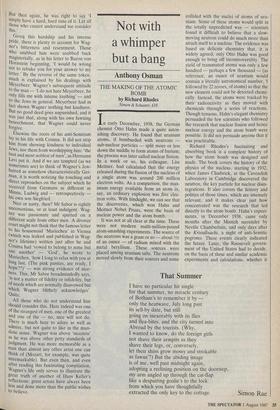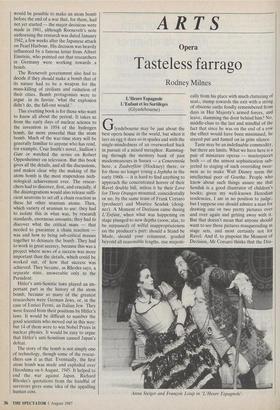Not with a whimper but a bang
Anthony Osman
THE MAKING OF THE ATOMIC BOMB by Richard Rhodes
Simon & Schuster, fI8
In early December, 1938, the German chemist Otto Hahn made a quite aston- ishing discovery. He found that uranium atoms, if bombarded with neutrons sub-nuclear particles — split more or less down the middle to form atoms of barium; the process was later called nuclear fission. In a week or so, his colleague, Lise Meitner, had calculated that the energy released during the fission of the nucleus of a single atom was around 200 million electron volts. As a comparison, the max- imum energy available from an atom in, say, an ordinary explosion was ,five elec- tron volts. With hindsight, we can see that the discoveries, which won Hahn and Meitner Nobel Prizes, were the basis of nuclear power and the atom bomb.
It was not at all clear at the time. These were not modern multi-million-pound atom-smashing experiments. The source of the neutrons was a gram or so — about 1/25 of an ounce — of radium mixed with the metal beryllium. These sources were placed among uranium salts. The neutrons moved slowly from their sources and some
collided with the nuclei of atoms of ura- nium. Some of these atoms would split in the totally unpredicted way — scientists found it difficult to believe that a slow- moving neutron could do much more than attach itself to a nucleus. The evidence was based on delicate chemistry that, it is widely agreed, only Otto Hahn was good enough to bring off incontrovertibly. The yield of transmuted atoms was only a few hundred — perhaps a few thousand — (as reference, an ounce of uranium would contain a literally astronomical number, 5 followed by 22 zeroes, of atoms) so that the new element could not be detected chemi- cally. Instead, the atoms were tracked by their radioactivity as they moved with chemicals through a series of reactions. Though tenuous, Hahn's elegant chemistry persuaded the few scientists who followed the research that nuclear fission and hence nuclear energy and the atom bomb were possible. It did not persuade anyone that it was practicable.
Richard Rhodes's fascinating and absorbing book is a complete history of how the atom bomb was designed and made. The book covers the history of the physics of the nucleus, starting in 1932, when James Chadwick, at the Cavendish Laboratory in Cambridge discovered the neutron, the key particle for nuclear disin- tegrations. It also covers the history and politics of those times, which are intensely relevant, and it makes clear just how concentrated was the research that led directly to the atom bonib. Hahn's experi- ments, in December 1938, came only months after the Munich surrender by Neville Chamberlain, and only days after the Kristallnacht, a night of anti-Semitic pogroms. These events clearly indicated the future. Later, the Roosevelt govern- ment of the United States had to decide, on the basis of these and similar academic experiments and calculations, whether it would be possible to make an atom bomb before the end of a war that, for them, had not yet started — the major decisions were made in 1941, although Roosevelt's note authorising the research was dated January 1942, a few weeks after the Japanese attack on Pearl Harbour. His decision was heavily influenced by a famous letter from Albert Einstein, who pointed out that researchers in Germany were working towards a bomb.
The Roosevelt government also had to decide if they should make a bomb that of its nature had to be a weapon for the mass-killing of civilians and ruination of their cities. Bomb protagonists were to argue in its favour 'what the explosion didn't do, the fall-out would.'
This rivetting book is for those who Want to know all about the period. It takes us from the early days of nuclear science to the invention in 1954 of the hydrogen bomb, far more powerful than the atom bomb. Much of the war-time story will be generally familiar to anyone who has read, for example, Cruz Smith's novel, Stallion's Gate or watched the series on Robert Oppenheimer on television. But this book gives all the details, and all the discussions, and makes clear why the making of the atom bomb is the most stupendous tech- nological achievement ever. The resear- chers had to discover, first, and crucially, if the disintegrations would also release suffi- cient neutrons to set off a chain reaction as these hit other uranium atoms. Then, which variety of uranium to use: they had to isolate this in what was, by research standards, enormous amounts; they had to discover what the critical mass — that needed to guarantee a chain reaction was and how to bring sub-critical masses together to detonate the bomb. They had to work in great secrecy, because this was a project where news of a success was more important than the details, which could be worked out, of how that success was achieved. They became, as Rhodes says, a separate state, answerable only to the President.
Hitler's anti-Semitic laws played an im- portant part in the history of the atom bomb, because so many of the greatest researchers were German Jews, or, in the case of Enrico Fermi, an Italian Jew. They were forced from their positions by Hitler's laws. It would be difficult to number the good scientists who moved out in this way: but 14 of them were to win Nobel Prizes in nuclear physics. It would be easy to argue that Hitler's anti-Semitism caused Japan's defeat.
The story of the bomb is not simply one of technology, though some of the resear- chers saw it as that. Eventually, the first atom bomb was made and exploded over Hiroshima on 6 August, 1945. It helped to end the , war against Japan. Richard Rhodes's quotations from the handful of survivors gives some idea of the appalling human cost.



















































 Previous page
Previous page